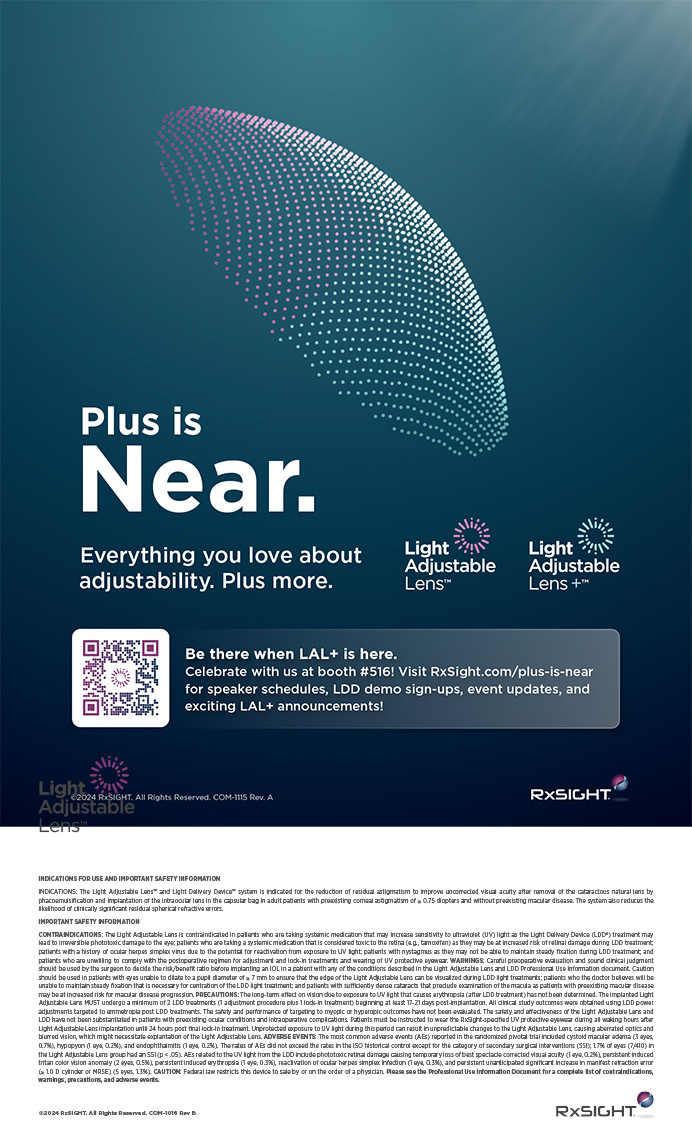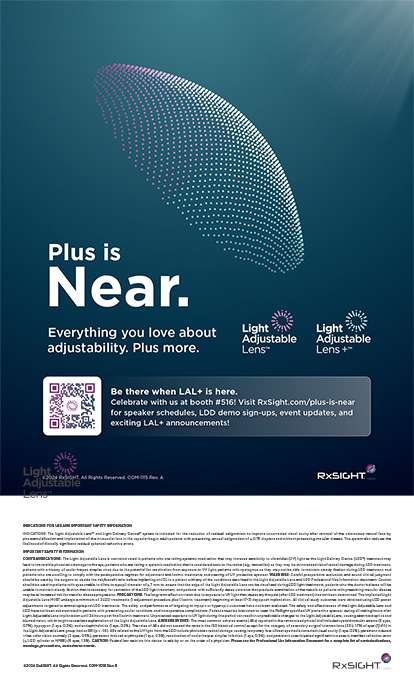
Special Report: American Academy of Ophthalmology Task Force Consensus Statement for Extended Depth of Focus Intraocular Lenses
MacRae S, Holladay JT, Glasser A, et al1

ABSTRACT
This report establishes the criteria defining extended-depth-of-focus (EDOF) lenses, a new class of IOLs. The consensus was that three criteria at minimum define EDOF IOLs:
1. a monocular mean distance BCVA comparable to that of monofocal IOL controls
2. a monocular depth of focus that is at least 0.50 D greater than the depth of focus achieved with a monofocal IOL at logMAR 0.2 (20/32)
3. a mean monocular distance-corrected intermediate visual acuity tested under photopic conditions at 66 cm at 6 months that is statistically significantly superior to that of the monofocal control IOL group, with at least 50% of eyes seeing better than or equal to logMAR 0.2 (20/32) at 66 cm
The task force also outlined specific methodology for acquiring defocus curves.
Visual acuity measurements should be taken in dark or dim lighting. Monocular defocus curve testing is conducted with distance refraction in place, after which the visual acuity is measured in 0.50 D defocus steps in the range of +1.50 and -2.50 D and in 0.25 D steps between +0.50 D and -0.50 D. The depth of focus is then graphically represented as the range of lens powers over which the mean acuity is 0.2 logMAR (20/32) or better. Both pupillary size and axial length can influence defocus measurements and should be evaluated by stratifying the data accordingly.
AT A GLANCE
- A task force established the minimal criteria for defining an extended-depth-of-focus (EDOF) IOL. They include a distance BCVA comparable to that of a monofocal lens, a depth of focus greater than 0.50 D at logMAR 0.2, and more than 50% of eyes seeing better than logMAR 0.2 at 66 cm 6 months postoperatively.
- An experimental study described the two principal technologies used in one EDOF IOL. Diffractive optical elements increased depth of focus and offset corneal longitudinal aberration. Refractive optics provided a base power and corrected for average corneal spherical aberration.
- A prospective comparative study of EDOF and monofocal IOLs found a high rate of spectacle independence and patient satisfaction with the former.
Contrast sensitivity testing at specified spatial frequencies must be performed with and without glare conditions, preferably with gratings using the Michelson criteria. The distance-corrected intermediate low-contrast acuity must be assessed at 66 cm under suboptimal conditions using the Weber definition of 10% monocular contrast, and these results should be compared to those with the monofocal control.
DISCUSSION
The importance of creating uniform criteria to govern study design and outcomes involving EDOF IOLs cannot be overemphasized. A standardized protocol allows accurate and objective measurement to help the FDA and clinicians understand visual outcomes with these IOLs and their performance under photopic, mesopic, and glare conditions.
Extending the Range of Vision Using Diffractive Intraocular Lens Technology
Weeber HA, Meijer ST, Piers PA2
ABSTRACT
Weeber and colleagues described an EDOF IOL and its function under experimental conditions. Two principal technologies are at work in this lens, which was developed commercially as the Tecnis Symfony IOL (Johnson & Johnson Vision). The first uses the principle of diffractive optics to achieve EDOF. Modifying specific geometrical parameters of a series of echelettes (eg, depth at the center and edge, diameter, and surface shape) can expand the focal range. Unlike multifocal IOLs, which disperse light energy to discrete primary focal lengths, the EDOF IOL creates a single elongated focus.
The second technology combines diffractive and refractive optics. In this hybrid design, the entire posterior optic surface is covered in a diffractive profile to offset corneal chromatic aberration and thereby increase retinal image quality, while the refractive optic provides a base power for the IOL and corrects the mean corneal spherical aberration. The echelettes are embedded seamlessly within the achromatic diffractive profile on the posterior optic surface, which does not result in extra visible diffractive rings.
Weeber and colleagues examined the EDOF IOL’s optical performance in a model eye using a modulation transfer function (MTF). They concluded that, in the range of -1.00 to -3.00 D defocus, the lens could improve visual acuity by 0.2 logMAR more than a monofocal IOL. The investigators predicted that the EDOF IOL would not carry some of the drawbacks associated with multifocal lenses such as reduced contrast sensitivity and a higher incidence of dysphotopsia.3
DISCUSSION
The investigators looked at the technologies that compose the Tecnis Symfony IOL and the clinical outcomes predicted by simulations in a clinically verified eye model. The important finding of this study is the improvement in visual acuity over a wider range of vision compared with a monofocal IOL, as determined with a through-frequency MTF and a 3-mm pupil. The MTF describes how the transfer of contrast information by an optical system decreases with increasing spatial frequency.4
In addition, the IOL did not demonstrate reduced contrast or the degree of glare or halos frequently associated with multifocal IOLs.3 Presumably, the counterbalance of corneal spherical aberration and the reduction in chromatic aberration of the eye offset the potential decrease in contrast from spreading light energy over an extended focus. Using the image of a small light source and imaging techniques with a high dynamic range, the investigators determined the extent of halos. Of note, when Gatinel and colleagues compared an EDOF IOL with a bifocal and a trifocal IOL in an optical bench study using point spread function to analyze halos, they found the relative amount to be similar among the three lenses.4
Longitudinal chromatic aberration can cause blur and reduce contrast vision.5,6 A diffractive achromatic profile offsets the refractive optic’s and cornea’s contributions to longitudinal chromatic aberration. Another study found that the EDOF IOL had a higher MTF when a +0.28-μm spherical aberration ISO2 model cornea was used.4 This finding likely reflects the IOL’s offsetting -0.27 μm of spherical aberration. Improvement in overall optical image quality is significant when both chromatic and spherical aberration is corrected.7
Of interest, a bench study comparing an EDOF IOL with a trifocal IOL with a +1.75 D addition for intermediate vision and a second power addition for near vision found that the trifocal IOL had a larger depth of focus than the EDOF IOL, which seemed to show some energy peaks at discrete foci. This MTF testing was done only at one spatial frequency, however, in the setting of monochromatic rather than polychromatic light. Moreover, the model included spherical but not chromatic aberration.4 The predictive bench outcomes must be carefully compared to the achieved clinical outcomes.
Comparative Analysis of the Clinical Outcomes With a Monofocal and Extended Range of Vision Intraocular Lens
Pedrotti E, Bruni E, Bonacci E, et al8
ABSTRACT
In a prospective study, Pedrotti and colleagues compared the clinical outcomes of a monofocal IOL versus the Tecnis Symfony lens in 80 eyes. The investigators took standard preoperative measurements, and the postoperative data collected included monocular and binocular uncorrected and corrected distance visual acuities, intermediate and near visual acuities, contrast sensitivity, and defocus curves. Postoperative examinations occurred at 1 day, 1 month, and 3 months.
Postoperatively, both groups achieved a binocular distance UCVA of 0.2 logMAR (20/30) or better. A binocular intermediate UCVA of 0.2 logMAR or better was obtained in 100% of EDOF eyes compared to 13.3% of monofocal eyes. Near UCVA was 0.2 logMAR or better in 100% and 6.7% of EDOF and monofocal eyes, respectively. Contrast sensitivity in photopic, mesopic, and scotopic light was found to be statistically the same in both groups. Defocus curve measurements in 0.50 D steps from +1.00 to -4.00 D confirmed that the EDOF group had superior visual acuity in most steps compared to the monofocal group. Study participants completed NEI RQL-42 quality-of-life questionnaires. Responses showed that the patients with the EDOF IOL were less dependent on optical correction without demonstrating a statistically significant increase in glare or dysphotopsia.
DISCUSSION
This study confirmed the outcomes predicted in prior studies such as that by Weeber et al.2 When discussing IOL options with patients, clinicians can derive confidence from the strong correlation between (1) the experimental studies and visual simulation with EDOF IOLs and (2) the measured clinical objective data and subjective responses obtained from patients who received EDOF IOLs. Activities of daily living have changed in the cataract patient population. Smartphones, tablets, and desktop computers place a greater emphasis on intermediate vision in varied lighting conditions.1 Patients who received the EDOF IOL in this comparative analysis by Pedrotti and colleagues were highly satisfied.
Prospective studies on a larger scale and of longer duration are required to evaluate the performance of implanted EDOF IOLs, including under mesopic conditions and in settings with glare stimuli. Other potential research of note includes testing the IOL in various levels of tilt and decentration and further comparisons of EDOF to multifocal IOLs with regard to spectacle independence.4,8 Because of the central ring’s wider diameter, EDOF IOLs may be less likely than multifocal lenses to cause photic phenomena in patients with a large angle kappa.9-11
1. MacRae S, Holladay JT, Glasser A, et al. Special report: American Academy of Ophthalmology Task Force consensus statement for extended depth of focus intraocular lenses. Ophthalmology. 2017;124(1):139-141.
2. Weeber HA, Meijer ST, Piers PA. Extending the range of vision using diffractive intraocular lens technology. J Cataract Refract Surg. 2015;41(12):2746-2754.
3. Calladine D, Evans JR, Shah S, Leyland M. Multifocal versus monofocal intraocular lenses after cataract extraction. Cochrane Database Syst Rev. 2016;(9):CD003169.
4. Gatinel D, Loicq J. Clinically relevant optical properties of bifocal, trifocal, and extended depth of focus intraocular lenses. J Refract Surg. 2016;32(4):273-280.
5. Negishi K, Ohnuma K, Hirayama N, Noda T; Policy-Based Medical Services Network Study Group for Intraocular Lens and Refractive Surgery. Effect of chromatic aberration on contrast sensitivity in pseudophakic eyes. Arch Ophthalmol. 2001;119(8):1154-1158.
6. Thibos LN, Ye M, Zhang X, Bradley A. The chromatic eye: a new reduced-eye model of ocular chromatic aberration in humans. Appl Opt. 1992;31(19):3594-3600.
7. Weeber HA, Piers PA. Theoretical performance of intraocular lenses correcting both spherical and chromatic aberration. J Refract Surg. 2012;28(1):48-52.
8. Pedrotti E, Bruni E, Bonacci E, et al. Comparative analysis of the clinical outcomes with a monofocal and an extended range of vision intraocular lens. J Refract Surg. 2016;32(7):436-442.
9. Tchah H, Nam K, Yoo A. Predictive factors for photic phenomena after refractive, rotationally asymmetric, multifocal intraocular lens implantation. Int J Ophthalmol. 2017;10(2):241-245.
10. Karhanová M, Pluháček F, Mlčák P, et al. The importance of angle kappa evaluation for implantation of diffractive multifocal intra-ocular lenses using pseudophakic eye model. Acta Ophthalmol. 2015;93(2):e123-128.
11. Prakash G, Prakash DR, Agarwal A, et al. Predictive factor and kappa angle analysis for visual satisfactions in patients with multifocal IOL implantation. Eye (Lond). 2011;25(9):1187-1193.




